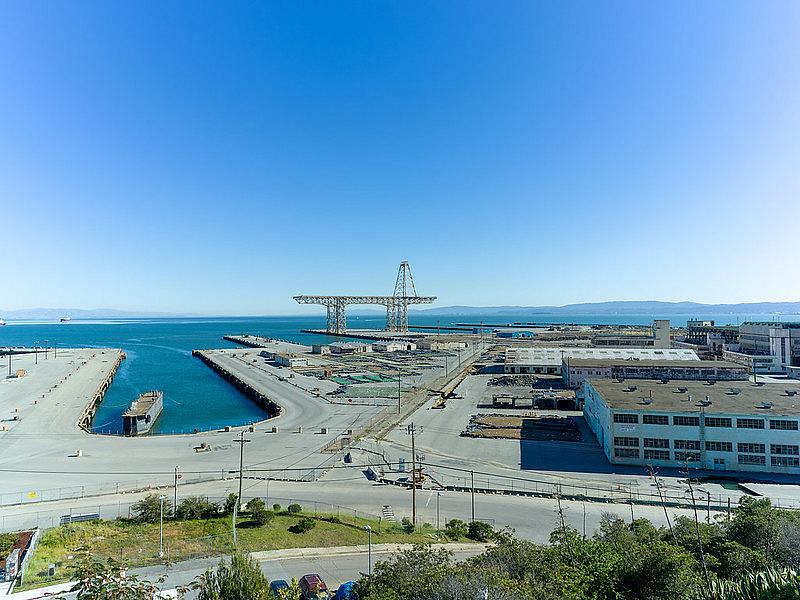What I learned about reporting on the massive cleanup of SF’s Hunters Point Shipyard

The Hunters Point Naval Shipyard in San Francisco, site of a major cleanup and redevelopment project.
Dale Cruse via Creative Commons/Flick
In July of 2018, Marie Harrison stood with her oxygen machine in front of a yellow protest banner. I waited, along with a couple of reporters from local Bay Area media outlets and a few dozen supportive protestors, for this longtime environmental advocate to speak.
Towering wood skeletons of unfinished housing dotted the surrounding hills, evidence of the largest building project in San Francisco history: 450 of 4,800 homes built, with an additional 4.1 million square feet of office space and 260 acres of parks.
All of this or most on toxic soil, according to Marie Harrison.
“Obviously you’ve noticed the extra equipment I’ve brought with me,” Harrison said. “I can't survive without it.”
Harrison spoke that day about the legacy of contamination in San Francisco’s southeastern neighborhood — her beloved Bayview neighborhood. I listened with a mixture of awe and shame. Even though I had lived in the Bay Area for twenty years, it was news to me that a Superfund cleanup site existed within San Francisco.
I interviewed Harrison a few times that year before she succumbed to respiratory arrest, most likely caused by the failure of her weakened lungs, scarred from years of inhaling the pollution that surrounds Bayview-Hunters Point. I knew I wanted to continue to tell her story.
As a freelance writer, I have the freedom to choose my projects, but I often miss the support and guidance of being part of a newsroom. Although I reported on Bayview-Hunters Point since meeting Harrison, the USC Center for Health Journalism Data Fellowship enabled me to go deeper into this complex story.
What I learned during this fellowship challenged but strengthened my resolve as a reporter. Here are a few of my key takeaways:
1. Data reporting is really just good reporting.
As we learned, data reporting is simply good reporting. If you were lucky enough to be awarded a fellowship, remember that you were chosen for your skills and potential as a journalist.
Because I feel more comfortable with words than numbers, I often had to remind myself that data is just one more piece of verifiable evidence that helps tell a complete story.
When I did feel overwhelmed by the scope and tight timeframe of the project, I had to remind myself that the process was well worth it. I was learning skills that would benefit me for the rest of my journalism career.
2. Determine the scope of the project as soon as possible.
Because I had reported on Bayview on and off since 2018, I had sources I could lean on. As far as scope, data scientists and experts much more skilled than me had spent decades collecting and compiling data sets that scrutinized the Shipyard. And my project coincided with the release of a detailed Civil Grand Jury report on the Shipyard and a study on groundwater changes with strong and reliable data.
Having that data available allowed me to focus on developing a narrative outline very early in the project.
3. Ask for help early and often.
As much as a reporter in the Data Fellowship should feel confident in their skills, I had to be sure to be just as aware of my weaknesses. Swallowing my pride and asking for help became essential to the long-term success of the project. My comfort with words far exceeds my comfort with numbers; only by leaning on my mentor and listening closely to the data experts could I navigate through this complex process. As a freelancer, I feel I’m often on my own, but this project required a collaborative effort.
4. Find the balance between the data and the narrative in your story.
Every story is different. Since the Hunters Point Naval Shipyard has been studied and analyzed for decades, there was an overwhelming amount of data available. The turning point came after a consult with my mentor who recognized that my specific story was more narrative-driven than data-driven.
Not to say one was more important than the other, since they both play essential roles and are partners in successful reporting. But my particular story would be heavy on narrative in order to add some humanity to the piles of data related to the cleanup.
5. Anticipate feeling overwhelmed, and embrace your team.
I am certainly not the only person moved by Marie Harrison’s story. And I often questioned if I was the best person to report on this specific subject.
But through collaboration with sources and experts, and with the excellent support of the fellowship community, I soon felt less like a lone freelancer and more of a team member tackling a very complex story that needed as many voices as possible.
The substantial power and money invested in the cleanup had to be met with as much scrutiny as possible to insure that the cleanup would be safe for all of San Francisco. That’s why I feel it’s important to choose not a one-off story for this in-depth project but a topic a reporter feels compelled to return to, knowing that the job is never really done.

